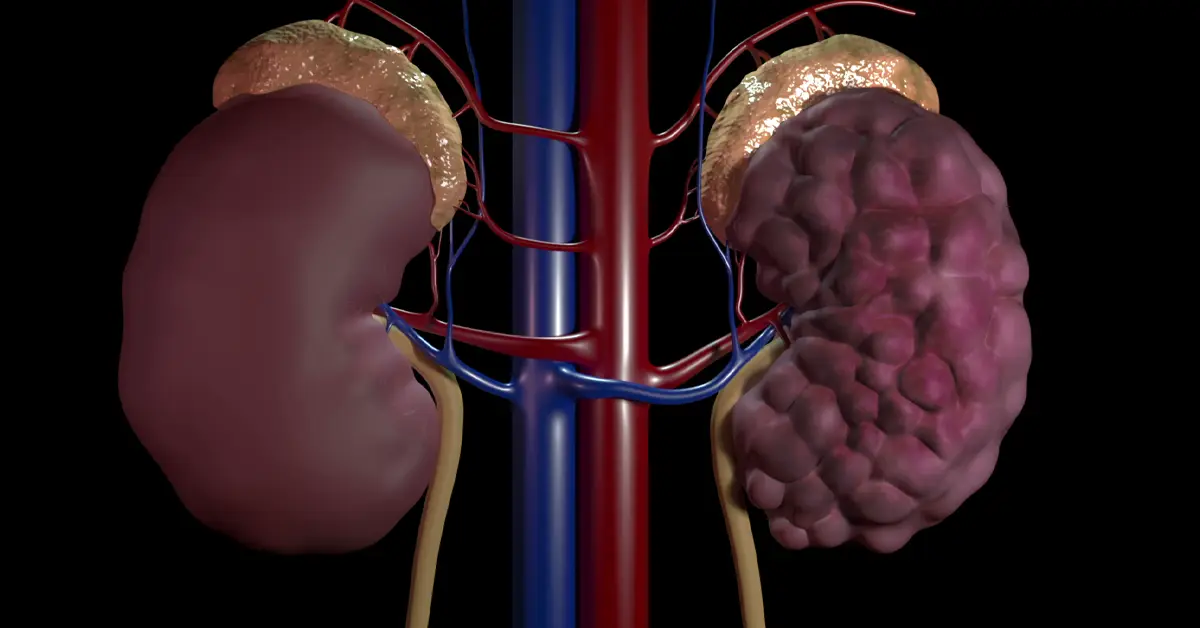Polycystic Kidney Disease (PKD) is a serious and potentially fatal genetic disorder that affects the kidneys. If left untreated, PKD can lead to kidney failure and even death. However, various management and treatments available can prolong the life of a person with PKD.
For healthcare providers, treating PKD requires various factors to be taken into consideration such as the patient’s gender, age, lifestyle, and more. Keeping track of these factors is not an easy task, but with the help of Remote Patient Monitoring (RPM), it can be done with ease. This article will discuss the various aspects of PKD and how RPM can help.
What is Polycystic Kidney Disease (PKD)?
Polycystic kidney disease (also known as PKD) is a genetic disease that causes the kidneys to grow numerous cysts. These cysts are generally filled with liquid. As many fluid-filled cysts grow or grow too large, the kidneys can be harmed. PKD cysts gradually affect a large part of the kidneys, reducing their functionality and ability to work.
The patient’s liver and other organs may also develop cysts due to PKD. Serious side effects of the illness include kidney failure and high blood pressure.
The severity of PKD varies greatly, and some complications can be prevented. Providing lifestyle change recommendations and proper treatments could help prevent kidney failure and other complications.
How Many People in the US have Polycystic Kidney Disease?
According to the National Kidney Foundation, there are around 600,000 people who have PKD in the US, making it the fourth leading cause of kidney failure. Men and women are equally at risk for the disease.
What are the Types of Polycystic Kidney Disease?
1. Autosomal Dominant PKD
Autosomal dominant PKD (ADPKD, sometimes called adult PKD) is the common form of polycystic kidney disease. It is a genetic disorder that causes cysts to grow in the kidneys.
This type of PKD often begins to show symptoms in adults between the ages of 30 and 50. Approximately half of those with ADPKD will have kidney failure by age 70. Over time, ADPKD can also affect the liver and other organs.
2. Infantile or Autosomal Recessive PKD
Infantile or autosomal recessive PKD is a rare form of the disease. This type of polycystic kidney disease often begins to show symptoms in infants or young children. That is why it is also called “infantile PKD” because the effects of this ailment start in babies even before they are born.
It is estimated that by the time they reach the ages of 15 or 16, 55% of children will have developed kidney failure. Other organs, like the liver, can also suffer damage from ARPKD.
3. Acquired Cystic Kidney Disease
Acquired cystic kidney disease (ACKD) occurs when a person’s kidneys gradually develop fluid-filled sacs known as cysts. ACKD is not a form of polycystic kidney disease but is rather a complication.
People who get dialysis are more likely to get cysts. The longer a person is on dialysis, the more likely they will get cystic kidney disease. But CKD or kidney failure, not dialysis treatments, is what causes the cysts.
What are the Symptoms of Polycystic Kidney Disease?
According to the National Kidney Foundation, many people with PKD do not develop symptoms until they reach the age range of 30 to 40.
Here are the symptoms of PKD:
- High blood pressure
- Blood in the urine
- Frequent urination
- Pounding in the chest
- Pain in the sides
- Urinary tract infections (UTI)
- Kidney stones
- Pain or heaviness in the back
- Skin that is prone to bruises
- Pale skin color
- Fatigue
- Joint pain
- Nail abnormalities
Symptoms for Children with Autosomal Recessive PKD:
- High blood pressure
- UTI
- Frequent urination
What are the Causes of Polycystic Kidney Disease?
Genetic mutations cause polycystic kidney disease. In most cases, the disease runs in families. It is a genetic disease that is transmitted from parents to offspring.
Autosomal dominant polycystic kidney disease (ADPKD)
Only one parent must have the disease for ADPKD to be passed on to the children. If one parent has ADPKD, each child has a 50% chance of developing the disease. The majority of PKD cases are of this type.
Autosomal recessive polycystic kidney disease (ARPKD)
Both parents must have abnormal genes to pass on this form of the disease. If both parents carry the genes, each child has a 25% chance of developing it.
Occasionally, a genetic mutation occurs spontaneously, with neither parent possessing a copy of the mutated gene.
What are the Common Complications of Polycystic Kidney Disease?
PKD can affect organs other than the kidneys. Cysts may form in the liver, pancreas, spleen, ovaries, and large intestine of individuals with PKD.
PKD can also affect the brain or heart. If PKD affects the brain, an aneurysm may occur. An aneurysm is a blood vessel bulging that can rupture, causing a stroke or even death. Some patients may develop a heart murmur if PKD affects the heart and causes the valves to become weak.
Approximately 50% of people with PKD will develop kidney failure by the age of 60 and 60% by the age of 70.
Other possible complications:
- High blood pressure
- Heart disease
- Kidney stones
- Diverticula, or pouches or pockets in the wall of the colon
- Cataracts or blindness
- Liver disease
- Mitral valve prolapse
- Anemia, or insufficient red blood cells
- Bleeding or bursting of cysts
How is Polycystic Kidney Disease Diagnosed?
Certain tests can be done to detect the size and the number of kidney cysts the patients have, as well as how much healthy kidney tissue remains.
Ultrasound
Ultrasound is the most reliable, affordable, and non-invasive method to diagnose PKD. An ultrasound is a medical procedure that utilizes a transducer to send sound waves into the patient’s body to identify the kidneys. A person at risk for PKD older than 40 and with a normal kidney ultrasound most likely does not have the disease.
CT Scan
A CT scan (computed tomography scan) and MRI (magnetic resonance imaging) may occasionally detect smaller cysts that an ultrasound cannot. With this device, the patient’s body is scanned with various thin X-ray beams. This allows you to observe a longitudinal and cross-sectional image of your patient’s kidneys.
MRI Scan
While inside a large cylinder, magnetic fields and radio waves create images of your patient’s kidneys. The volume and growth of kidneys and cysts are measured and monitored using MRI.
Genetic testing
There are also times when genetic testing might be done to diagnose PKD. It can help when a person has an uncertain diagnosis based on imaging tests or has a family history of PKD who wants to donate a kidney or plans to start a family.
What are the Treatment Options for Polycystic Kidney Disease?
Blood pressure management is important in people with polycystic kidney disease, as high blood pressure can lead to further kidney damage.
Breathing support may be necessary for some people with polycystic kidney disease. This is because the kidneys regulate fluid levels in the body, and when they are not functioning properly, fluid can build up in the lungs.
ADPKD can be treated with a drug called tolvaptan, sold under the brand name Jynarque. The Food and Drug Administration approved this drug in 2018. It is used to slow down the decline of the kidneys. Since severe liver damage is one of the serious potential side effects of tolvaptan, doctors will frequently check the condition of the patient’s liver and kidneys while taking this medication.
Dialysis and kidney transplant may be required for patients with advanced PKD that results in renal failure. The kidneys may need to be removed, either one or both.
People with PKD can use a variety of supportive treatments to control their symptoms, slow the growth of cysts, and prevent or slow the loss of kidney function. These treatments include:
- Prompt antibiotic treatment for bladder or kidney infections
- Consuming plenty of fluids when blood urine is first detected
- Taking prescribed medication to control pain
- Healthy lifestyle (quitting smoking, exercising, weight management, reducing salt intake, reducing stress)
- Avoiding all beverages containing caffeine
A healthcare provider, can recommend community support groups to their patients if the disease affects their mental health. A counselor, psychologist, or psychiatrist can also provide assistance. Support groups can provide beneficial information regarding treatments and coping strategies.
Nutrition for Polycystic Kidney Disease Patients
Polycystic Kidney Disease (PKD) is a genetic disorder that affects the kidneys and can lead to kidney failure. Healthcare providers, should advise proper nutrition for patients with PKD. Adequate nutrition can help manage symptoms of the disease and reduce the risk of developing serious complications.
Good nutrition includes eating nutrient-rich foods in appropriate amounts throughout the day. Reduced salt intake helps control high blood pressure. To maintain a healthy weight, a low-fat, moderate-calorie diet is recommended. Staying hydrated by drinking the appropriate amount of fluid may help slow the progression of PKD to kidney failure.
Exercise for Polycystic Kidney Disease Patients
As a healthcare provider, the importance of regular exercise for PKD patients should not be overlooked. Physical activity helps reduce blood pressure, improve muscle and bone strength, and lower the risk of heart disease – all of which are important for managing PKD.
Regular exercise also contributes to healthy nutrition. It helps to maintain or lose weight, regulate blood sugar levels and reduce cholesterol levels if necessary; all elements that can help improve kidney function in PKD patients. Additionally, regular physical activity can help decrease fatigue which is a common symptom associated with this disorder.
Healthcare providers should evaluate their patient’s health condition before recommending an exercise regimen.
Remote Patient Monitoring for Polycystic Kidney Disease Patients
Remote patient monitoring (RPM) has become an integral part of the care plan for patients with polycystic kidney disease (PKD). Early detection and treatment of PKD are essential to slow the progression of the disease and prevent complications.
RPM allows for close monitoring of PKD patients without them having to visit the office for every appointment. Patients wear a medical device that monitors their blood pressure, heart rate, and other vital signs. The data from the device is transmitted wirelessly to the patient’s care team.
RPM can improve outcomes in PKD patients by allowing for earlier detection and intervention of problems. It also helps to reduce hospitalizations and emergency room visits.
DrKumo, a multi-awarded RPM company, provides Remote Patient Monitoring (RPM) and Disease Management Programs (DMPs) that feature real-time patient health data transmission from RPM medical devices to a highly-secure cloud-based platform. DrKumo is a URAC-accredited company in Telehealth Support Services 2.0.
Healthcare Providers’ Goals for Patients with Polycystic Kidney Disease
Healthcare providers have recently been focusing on a new set of goals to help patients suffering from Polycystic Kidney Disease (PKD). These goals are intended to improve the quality of life and well-being of those who struggle with this condition every day. In this section, we will explore these objectives as well as some implementation steps healthcare providers can take to ensure they are met.
The primary goal for healthcare providers working with PKD patients should be to develop comprehensive, individualized treatment plans based on each patient’s medical history and specific needs. Treatment plans should focus on identifying potential risk factors associated with worsening symptoms, such as high blood pressure or cardiovascular disease. In addition, healthcare providers should educate patients on how to self-manage their symptoms through lifestyle modification and medication management, where appropriate. Here are the other important goals:
- Early detection, accurate diagnosis, and accurate prognosis of kidney outcomes and disease progression.
- Choosing the right ways and technology to treat and manage PKD throughout the course of a patient’s illness.
- Complication screening, symptom monitoring and management, and comorbidity treatment.
- Pay attention to the unique implications of inherited kidney disease, which can affect more than one generation and a patient’s plans for having children now or in the future.
- Throughout these steps, the focus should be on giving patients and their families the tools they need to be as involved as possible in care plans and disease self-management.
Remote patient monitoring (RPM) has been identified as an effective tool for managing this complex chronic condition. RPM helps healthcare providers provide remote patient education, track symptoms, and monitor treatment outcomes without having to see the patient in person.
Incorporating RPM into your goals for PKD patients involves establishing baseline data of key indicators such as weight and blood pressure readings; these are used to detect changes that may indicate a change in clinical status or an adverse reaction to medications. Healthcare providers also use RPM to send reminders about medications, appointments, and lifestyle modifications that can help manage PKD symptoms more effectively. Healthcare providers’ main goal when using RPM with PKD patients is to reduce the risk of complications that come with the condition, such as hypertension and end-stage renal failure.
Takeaways
This article about Polycystic Kidney Disease (PKD) has outlined key points for healthcare providers to consider when treating patients. It is important to be aware of the symptoms, risk factors, and treatments available for PKD. It is important for doctors and other healthcare providers to stay up-to-date on advances in treatment methods and continually strive to provide the best care possible for their patients.
Remote Patient Monitoring (RPM) of PKD is proving to be an effective way to treat and manage the disease. It allows patients to live their lives with more comfort, ease, and autonomy while allowing physicians to monitor the patient’s health from a distance. With further developments in technology and research, remote patient monitoring for PKD will only become increasingly reliable and accessible. This is especially important as PKD is a life-threatening condition that requires constant vigilance.
We encourage you to take advantage of our technology and join the growing community of healthcare providers using it to improve patient care. Contact us to learn more today.








